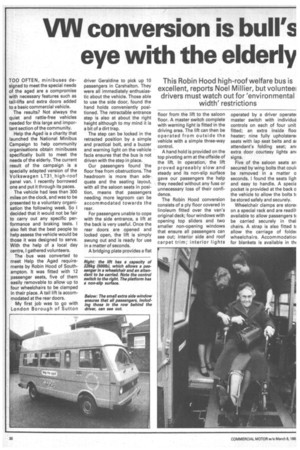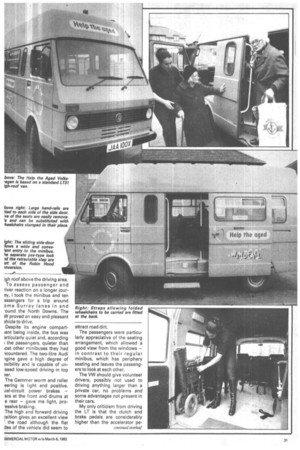VW conversion is bull's eye with the elderly
Page 22

Page 23

If you've noticed an error in this article please click here to report it so we can fix it.
TOO OFTEN, minibuses designed to meet the special needs of the aged are a compromise with necessary features such as tail-lifts and extra doors added to a basic commercial vehicle.
The results? Not always the quiet and rattle-free vehicles needed for this large and important section of the community.
Help the Aged is a charity that launched the National Minibus Campaign to help community organisations obtain minibuses specifically built to meet the needs of the elderly. The current result of the campaign is a specially adapted version of the Volkswagen LT31_ high-roof panel van. I recently borrowed one and put it through its paces.
The vehicle had less than 300 miles on the clock, and was to be presented to a voluntary organisation the following week. So I decided that it would not be fair to carry out any specific performance and braking tests. I also felt that the best people to help assess the vehicle would be those it was designed to serve. With the help of a local day centre, I gathered volunteers.
The bus was converted to meet Help the Aged requirements by Robin Hood of Southampton. It was fitted with 12 passenger seats, five of them easily removable to allow up to four wheelchairs to be clamped in their place. A tail lift is accommodated at the rear doors.
My first job was to go with London Borough of Sutton driver Geraldine to pick up 10 passengers in Carshalton. They were all immediately enthusiastic about the vehicle. Those able to use the side door, found the hand holds conveniently positioned. The retractable entrance step is also at about the right height although to my mind it is a bit of a dirt trap.
The step can be locked in the retracted position by a simple and practical bolt, and a buzzer and warning light on the vehicle facia ensures that the bus is not driven with the step in place.
Our passengers found the floor free from obstructions. The headroom is more than adequate and the seating layout, with all the saloon seats in position, means that passengers needing more legroom can be accommodated towards the rear.
For passengers unable to cope with the side entrance, a lift at the back is very useful. Once the rear doors are opened and locked open, the lift is simply swung out and is ready for use in a matter of seconds.
A bridging plate provides a flat floor from the lift to the saloon floor. A master switch complete with warning light is fitted in the driving area. The lift can then be operated from outside the vehicle with a simple three-way control.
A hand hold is provided on the top pivoting arm at the offside of the lift. In operation, the lift proved agreeably slow and steady and its non-slip surface gave our passengers the help they needed without any fuss or unnecessary loss Of their confidence.
The Robin Hood conversion consists of a ply floor covered in linoleum fitted over the van's original deck; four windows with opening top sliders and two smaller non-opening windows that ensure all passengers can see out; interior side and roof carpet trim; interior lights operated by a driver operate( master switch with individue controls on each of four unit fitted; an extra inside floo heater; nine fully upholsterel seats with lap seat belts and ai attendant's folding seat; an extra door courtesy lights an( signs.
Five of the saloon seats an secured by wing bolts that coull be removed in a matter seconds. I found the seats ligh and easy to handle. A specie pocket is provided at the back o the vehicle to allow the bolts t( be stored safely and securely.
Wheelchair clamps are store( on a special rack and are readil, available to allow passengers tl be carried securely in thei chairs. A strap is also fitted ti allow the carriage of folde( wheelchairs. Accommodatiol for blankets is available in thi igh roof above the driving area. To assess passenger and river reaction on a longer jouray, I took the minibus and ten assengers for a trip around rime Surrey lanes in and .ound the North Downs. The W proved an easy and pleasant ahicle to drive.
Despite its engine compartlent being inside, the bus was articularly quiet and, according I the passengers, quieter than iost other minibuses they had 'countered. The two-litre Audi "gine gave a high degree of axibility and is capable of unIssed low-speed driving in top aar.
The Gemmer worm and roller eering is light and positive. ual-circuit power brakes — scs at the front and drums at rear — gave me light, provssive braking.
The high and forward driving nition gives an excellent view the road although the flat des of the vehicle did seem to attract road dirt.
The passengers were particularly appreciative of the seating arrangement, which allowed a good view from the windows — in contrast to their regular minibus, which has periphery seating and leaves the passengers to look at each other.
The VW should give volunteer drivers, possibly not used to driving anything larger than a private car, no problems and some advantages not present in their cars.
My only criticism from driving the LT is that the clutch and brake pedals are considerably higher than the accelerator pe
































































